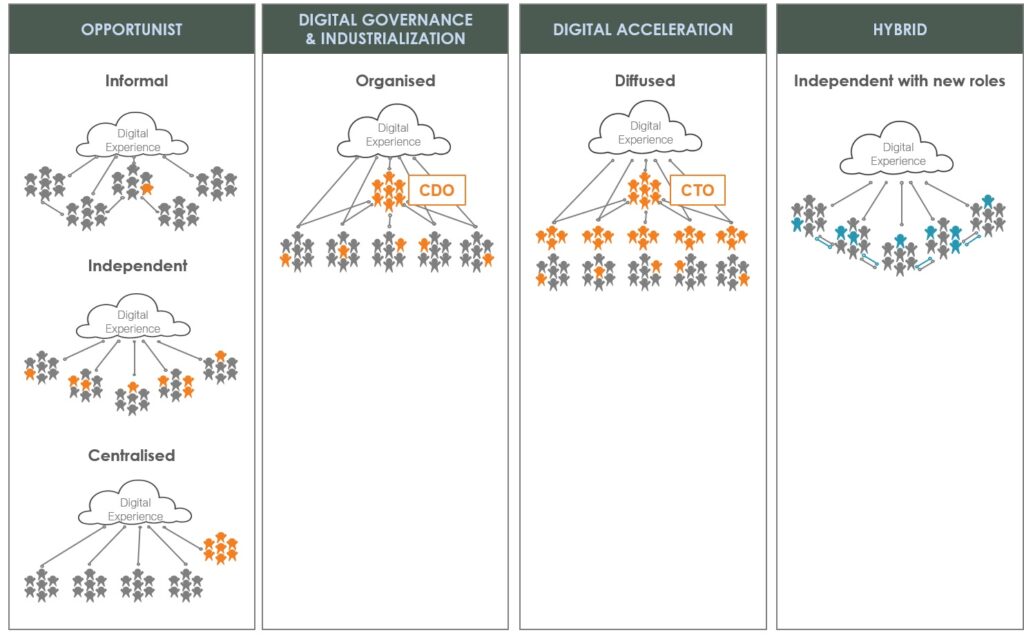
Nowadays, the importance of digital transformation for your business is unavoidable. However, some questions still remain: What does digital transformation actually mean? How should it be implemented? What is the purpose behind it?
Depending on your organisation’s digital maturity, we will in this article suggest different ways to help you on your journey to digitally transform.
First of all, digital transformation means gradually introducing the digital component into each function and operation across your organisation. This can be done either by internalising digital jobs or by acquiring an ecosystem of external partners for what cannot be internalised. The end goals of your company’s transformation are to provide a seamless customer experience and achieving the status of a Hybrid Model.
In concrete terms, the result of digitally transforming your business is an agile organisation that combines traditional jobs with new ones, whose business models are enriched and diversified, whose corporate values revolve around a greater integration of the digital element in the workplace, and whose management has developed an entrepreneurial mindset. It is, however, crucial for the elements above to all preserve a human dimension. This hybrid model allows for a well-equipped agile organisation that can face the challenges of rapid technological and social change.
Digital transformation can be explained through four different steps: Grasping Opportunities, Digital Governance & Industrialisation, Digital Acceleration, and Hybrid Model.
The 4 Steps Towards The Hybrid Organisation

Source: adapted from Four Models for Managing Digital at Your Organization SSI review; Organizing for Digital Innovation BCG
Digital Management: Grasping Opportunities
In this first phase, digital transformation is addressed through independent initiatives organisation-wide. For instance, the communication department manages social network channels on their own terms without consulting the marketing department, whereas customer data is only analysed by the CRM team – while an e-commerce ad-hoc team is created alongside the distribution teams. In other words, a silo-effect is verified within the company.
This is a common way to start a digital transformation, but soon management starts realising their financial revenues don’t meet their initial expectations: team collaboration around digital channels turns out to be more complex and confrontational than expected. The customer experience becomes chaotic, and performance indicators no longer allow for a holistic understanding of the company’s operations.
These types of obstacles lead to the following question: What now? At this stage, it is important to realise that a digital transformation is not only the job of the digital experts, but that it should involve all employees across the organisation. The weaving of a common thread is therefore essential to foster internal coherence and collaboration because only then will all actors and departments alike be aligned.
Digital Transformation: When Orchestrated By The Chief Digital Officer
The Chief Digital Officer (CDO) is a member of the executive committee and reports directly to the CEO. His or her tasks are focused in the areas of digital transformation, data, customer experience, employee experience, training, open innovation, digital technologies, and external partners. The CDO is not the head of digital, they are a transformer. Internal coherence is essential when it comes to digitally transforming your business. This is achieved through an integrated company approach which involves, as a first step, reflecting the company’s vision. Together with their team, the CDO’s aim is to, in a creative and innovative way, enrich the company’s vision by reconciling the traditional and digital worlds so as to ensure a smooth digital transformation. A central digital team is then set up to oversee and assist this internal transformation.
The centralised approach we just described, however, is temporary. Once the projects are up and running, awareness of further digital implementation should be encouraged across the entire organisation. When the management team becomes the ambassador of digital transformation, the CDO knows it’s an accomplished mission.
Business Transformation: A Digital Mindset Is Everyone’s Responsibility
In the third phase, digitalisation is spread throughout the company based on a shared vision and objectives, especially regarding the customer and employee experience – essential elements to accelerate the company’s digital transformation. During this phase, the CDO hands over to the Chief Transformation Officer (CTO).
A more in-depth transformation of the company, business growth, and continuous technological development now represents the challenge to overcome. In order to tackle it the CTO, in collaboration with the HR department, encourages ongoing learning and the development of a growth mindset amidst the company’s employees. Together with testing and retaining the most sustainable business models, the CTO can aim to successfully reach the main goal of digital transformation: reaching a Hybrid Model.
Digitalisation’s special feature lies in its ability to learn and execute itself through a kind of Do-It-Yourself approach. In other words, employees acquire the autonomy to train themselves by collaborating with the company’s digital experts. This collaboration makes room for a more agile and entrepreneurial mindset which, when reached, will symbolise the successful transformation of the company.
Hybrid Organisation: The Goal To Be Reached
In this fourth and last phase the new business models are launched, the digital elements are set up throughout the organisation and new jobs have emerged. According to the executive committee:
- Customer experience has become a central function;
- Products and services are designed together with the customers;
- Online and physical sales fall under the responsibility of one ‘omnichannel’ manager;
- Customer data is centralised;
- Brand strategy has merged with communication;
- Technological tools have spread throughout the company, while the IT department remains in charge of ensuring a robust and flexible IT platform.
The Hybrid Organisation model makes it all the more possible to deal with new and unexpected situations such as rapidly changing environments, new technologies or ever-evolving customer needs and expectations. Employees across the company have acquired an entrepreneurial mindset and an ability to quickly adapt to any changes in their role. Digital experts have managed to integrate historical business successfully. Both customers and employees experience a consistent and homogeneous brand regardless of the channels used.
These steps are not necessarily sequential. Depending on the organisation and its culture, digital maturity, and internal leadership, a Hybrid Model could be implemented at once. However, we notice that companies that skip the ‘CDO’ stage face difficulties in filling the gaps and transiting smoothly towards the Hybrid Model. However, if the phases are to be implemented, it is essential for each and every one of them to be led by a suitable CDO and CTO. The company’s responsibility then lies in providing meaningful support to the newly appointed leader, through the good and the bad times, through failures and achievements, through gains and losses.

Geraldine Maouchi, Global Chief Digital Officer, ALPHA HealthGroup

Hélène Musikas, Affiliate Professor of Strategy, HEC Paris Business School


